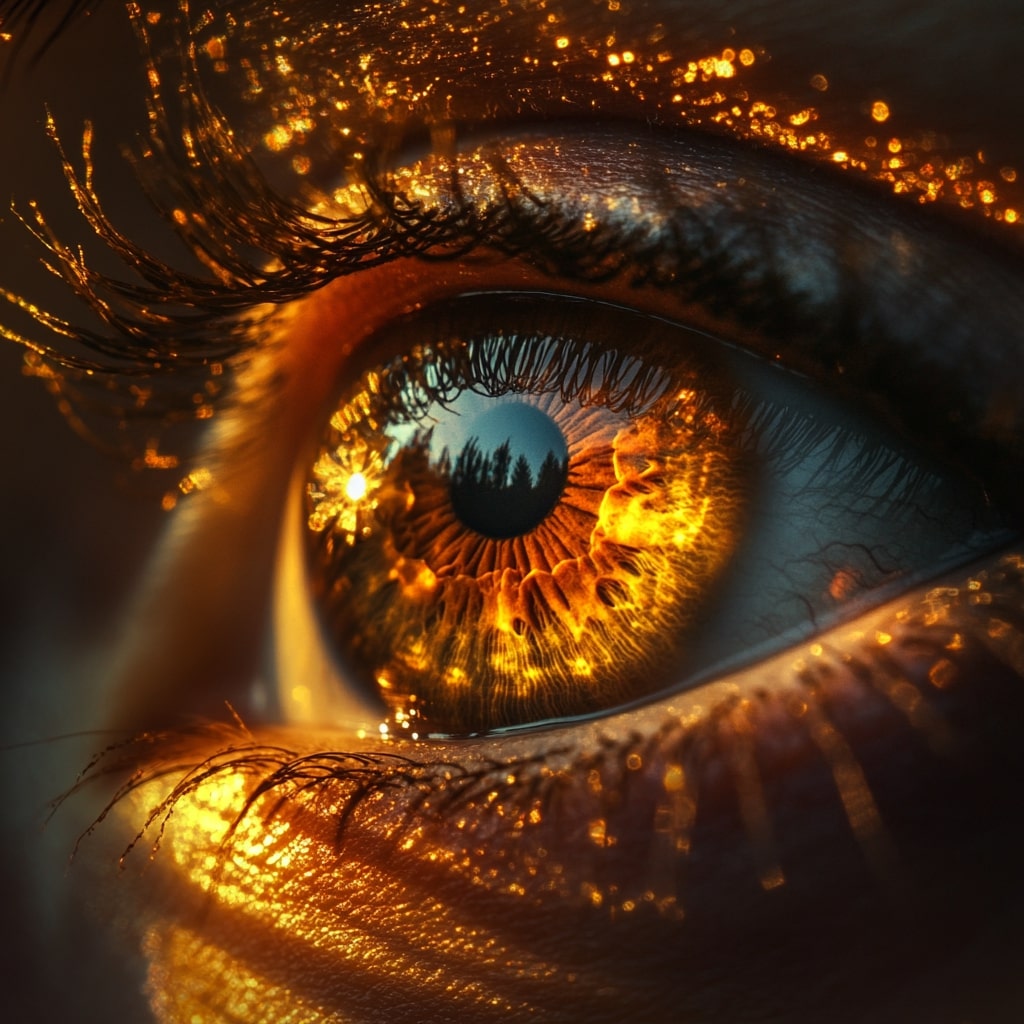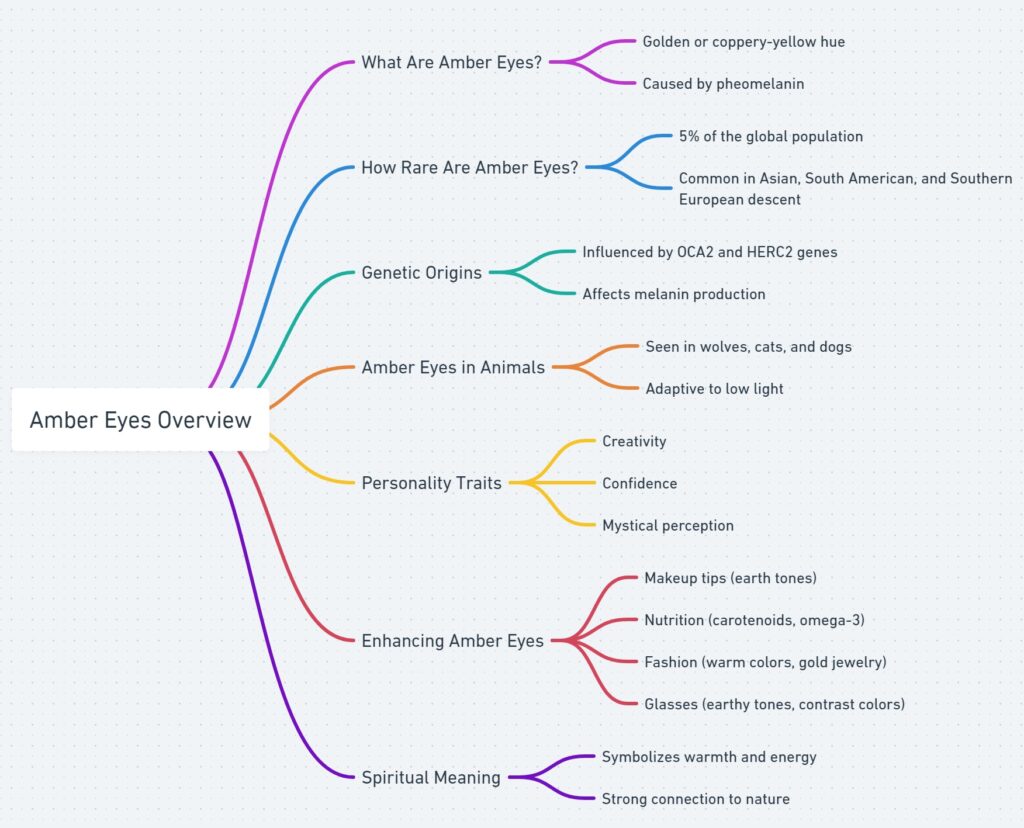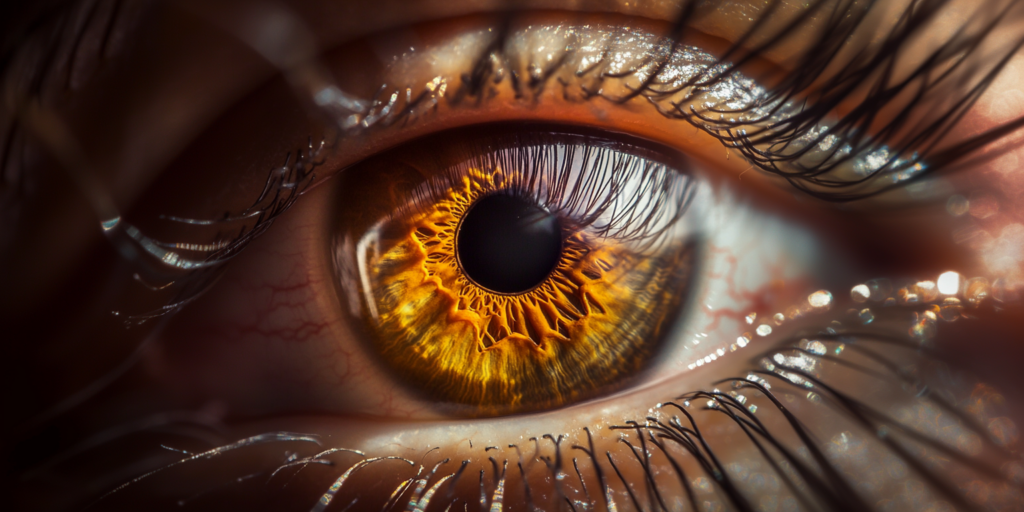Amber Eyes: The Rare and Captivating Eye Color Explained
Amber eyes are one of the rarest and most striking eye colors in the world, often compared to the warmth and glow of precious amber stone. With an estimated prevalence of only 5% of the global population, amber eyes are an extraordinary feature that naturally draws attention. If you’re curious about what makes amber eyes unique, their origin, or if you want to know more about their meaning and perception, you’re in the right place. In this article, we’ll explore everything about amber eyes, backed by scientific research and captivating details, to help you better understand this extraordinary eye color.


Key Takeaways
| Section | Key Takeaway |
|---|---|
| What Are Amber Eyes? | Amber eyes are defined by a golden or coppery-yellow hue, caused by the presence of pheomelanin. |
| How Rare Are Amber Eyes? | Amber eyes are very rare, occurring in only about 5% of the global population. |
| Genetic Origins of Amber Eyes | Amber eyes are influenced by multiple genes, primarily OCA2 and HERC2, affecting melanin production. |
| Amber Eyes in Animals | Seen in wolves, cats, and dogs, amber eyes serve as an adaptation to various light conditions. |
| Personality Traits Associated with Amber Eyes | Amber eyes are linked to creativity, confidence, and a mystical perception in many cultures. |
| Are Amber Eyes the Same as Hazel Eyes? | Amber eyes have a consistent golden hue, unlike the varied pigments in hazel eyes. |
| Celebrities with Amber Eyes | Celebrities like Nicole Richie and Shakira have captivating amber eyes, adding to their charm. |
| How to Enhance Amber Eyes | Makeup techniques with warm, earthy tones can make amber eyes stand out. |
| Amber Eyes and the Right Nutrition | Foods rich in carotenoids, omega-3 fatty acids, and antioxidants can enhance amber eyes‘ vibrancy. |
| Fashion Tips: Clothing to Enhance Amber Eyes | Clothing in warm shades and jewel tones can highlight the uniqueness of amber eyes. |
| Choosing the Right Glasses for Amber Eyes | Frames in earthy tones or contrasting colors can accentuate amber eyes beautifully. |
| Spiritual and Symbolic Meaning of Amber Eyes | Amber eyes symbolize warmth, energy, and a strong connection to nature in various cultures. |
What Are Amber Eyes?
Amber eyes are characterized by a golden or coppery-yellow hue, often with hints of hazel or green. Unlike brown eyes, which have more melanin, amber eyes have a distinct yellowish pigmentation caused by the presence of lipochrome, also known as pheomelanin, a pigment that gives them a glowing appearance. According to a 2019 study published in the Journal of Human Genetics, amber eyes are distinguished by their warm, consistent golden tone, rather than the varied mixture of colors seen in hazel eyes.
Key Features of Amber Eyes:
-
Unique golden or coppery-yellow hue
-
Presence of pheomelanin giving them a glowing appearance
-
Often mistaken for hazel eyes but have a consistent tone
How Rare Are Amber Eyes?
Amber eyes are incredibly rare, making up approximately 5% of the world’s population. This rarity makes them highly fascinating, often thought to possess an almost supernatural quality. Amber eyes are most commonly found in people of Asian, South American, and Southern European descent. However, they can appear in people of all ethnicities due to genetic variation. A 2021 genetic survey conducted by researchers at the University of Copenhagen found that the prevalence of amber eyes is most prominent in rural regions of South America and parts of East Asia.
Factors Contributing to Rarity:
-
Prevalence in only 5% of the population
-
Most commonly seen in specific ethnicities (Asian, South American, Southern European)
-
Genetic variation across different populations

Genetic Origins of Amber Eyes
The genetics behind amber eyes are complex and still under study, but it is understood that eye color is determined by multiple genes, particularly OCA2 and HERC2, which influence melanin production. Amber eyes have a unique combination of melanin and lipochrome, resulting in the beautiful golden hue. In contrast, eye colors like blue or green have less melanin, and brown eyes have a higher concentration of melanin. According to a study by Nature Genetics, the presence of pheomelanin is what differentiates amber eyes from other eye colors, giving them a yellow to copper tone that can sometimes appear to glow in sunlight.
Genetic Factors at Play:
-
Multiple genes, including OCA2 and HERC2, influence melanin production
-
Unique combination of melanin and pheomelanin
-
Differences from other eye colors in terms of melanin concentration
Studies say:
Amber eyes are a rare eye color characterized by a solid golden or coppery hue, resulting from a high concentration of the yellow pigment lipochrome (pheomelanin) in the iris.
Genetically, amber eyes are believed to be a variation of green eyes, with mutations in genes such as OCA2 and HERC2 on chromosome 15 leading to increased lipochrome production.
This genetic trait is inherited in a recessive pattern, meaning both parents must pass on the same gene variants for their child to develop this eye color.
Amber Eyes in Animals
Interestingly, amber eyes are not limited to humans; they are frequently seen in animals, including wolves, cats, and even some dogs. The same lipochrome pigment that gives humans amber eyes also gives these animals their distinct, piercing gaze. Wolves, in particular, are known for their striking amber eyes, which add to their mystical reputation. In fact, the association of amber eyes with wolves has been a contributing factor to the mythical and supernatural allure that surrounds this eye color. A 2018 study in Animal Genetics concluded that the prevalence of amber eyes in certain wolf species is due to the need for adaptation to various light conditions, enhancing their hunting ability at dawn and dusk.
Personality Traits Associated with Amber Eyes
Amber eyes are often associated with specific personality traits, including creativity, confidence, and warmth. These associations, while largely based on folklore and anecdotal evidence, are interesting nonetheless. In many cultures, people with amber eyes are perceived as mysterious, exotic, and deeply connected to nature. A 2016 survey published in Personality and Individual Differences suggested that individuals with rare eye colors, including amber, are more likely to be perceived as adventurous and spontaneous by others. Though these traits are not scientifically proven to be linked to eye color, they add to the mystique of amber eyes.
Commonly Associated Traits:
-
Creativity and originality
-
Confidence and warmth
-
Mystical or exotic perception in many cultures
Are Amber Eyes the Same as Hazel Eyes?
Amber eyes are often confused with hazel eyes, but they are distinctly different. Hazel eyes usually contain a mixture of brown, green, and sometimes blue, with a tendency to change color in different lighting conditions. Amber eyes, on the other hand, have a more uniform golden or copper hue and do not change colors as dramatically. A clinical analysis published in the American Journal of Ophthalmology in 2020 highlighted that while hazel eyes exhibit multiple pigments that lead to varying appearances, amber eyes contain a dominant presence of pheomelanin, leading to a consistent, glowing color.


Celebrities with Amber Eyes
A few celebrities are known for their captivating amber eyes, adding to their allure and uniqueness. Notable figures with amber eyes include actress Nicole Richie and singer Shakira. Their distinctive eye color has often been highlighted as part of their charm and beauty, emphasizing how rare and stunning amber eyes can be. A 2015 interview with Vogue revealed that Shakira’s unique eye color has been a key part of her visual identity, adding an element of warmth and charisma to her performances.
Famous Celebrities with Amber Eyes:
-
Nicole Richie: Known for her warm, captivating look
-
Shakira: Adds to her unique charm and visual identity
-
Ed Speleers: Actor with striking amber eyes often featured in his roles
How to Enhance Amber Eyes
If you have amber eyes and want to make them stand out, there are several makeup techniques that can help. Warm, earthy tones such as copper, gold, and bronze tend to bring out the golden hue in amber eyes. Using eyeshadows in complementary colors like deep green or plum can also create a striking contrast that enhances the depth and brightness of this rare eye color. Eyeliners in shades of brown or forest green can further add definition to the eyes, making the amber color appear even more vivid. Professional makeup artist Lisa Eldridge once mentioned in an interview that using metallic tones can amplify the natural glow of amber eyes, making them truly mesmerizing.
Makeup Tips for Amber Eyes:
-
Eyeshadows: Use copper, gold, bronze, or plum shades
-
Eyeliner Colors: Brown or forest green to enhance definition
-
Highlighting: Metallic tones can amplify the natural glow
Amber Eyes and the Right Nutrition
Diet can have a surprising effect on the vibrancy of your eye color. While it won’t change your eye color completely, certain nutrients can enhance the natural glow of amber eyes. Eating foods rich in carotenoids, such as carrots, sweet potatoes, and pumpkins, can help intensify the golden hue of amber eyes. Omega-3 fatty acids, found in fish like salmon, can also support eye health and maintain their brightness. Antioxidants such as vitamins A, C, and E are vital for reducing oxidative stress, which can dull eye color over time.
Nutritional Tips to Enhance Amber Eyes:
-
Carotenoid-Rich Foods: Carrots, sweet potatoes, pumpkins
-
Omega-3 Fatty Acids: Salmon, walnuts, flaxseeds
-
Antioxidants: Foods rich in vitamins A, C, and E
Fashion Tips: Clothing to Enhance Amber Eyes
Choosing the right colors in your clothing can make amber eyes shine even more brilliantly. Warm shades such as mustard yellow, rich browns, burnt orange, and forest green can bring out the golden tones of amber eyes. Jewel tones like emerald and deep turquoise can provide a beautiful contrast that highlights the uniqueness of amber eyes. Accessorizing with gold jewelry can also draw attention to the warm undertones and make the eyes appear even more radiant.
Fashion Tips for Amber Eyes:
-
Clothing Colors: Mustard yellow, burnt orange, forest green, rich browns
-
Jewel Tones: Emerald, deep turquoise
-
Accessories: Gold jewelry enhances warm undertones
Choosing the Right Glasses for Amber Eyes
The right eyewear can also help accentuate the beauty of amber eyes. Frames in earthy tones such as tortoiseshell, copper, or bronze can complement amber eyes beautifully, enhancing their natural warmth. For a more striking look, frames in green or deep blue can create an appealing contrast, making the eyes pop. Clear or golden-hued frames are also great choices if you want the focus to remain entirely on your eyes. When choosing glasses, make sure to consider your skin tone and face shape to find the perfect match that highlights your unique features.
Glasses to Highlight Amber Eyes:
-
Frame Colors: Tortoiseshell, copper, bronze
-
Contrasting Colors: Green or deep blue frames
-
Subtle Enhancement: Clear or golden-hued frames
The Spiritual and Symbolic Meaning of Amber Eyes
Amber eyes are often linked with warmth, energy, and the power of the sun. In various cultures, people with amber eyes are thought to possess a deep connection to nature, heightened intuition, and even spiritual energy. Ancient folklore from the Andean region believed that individuals with amber eyes could communicate with the spirits of the earth, acting as natural healers. The spiritual significance of amber eyes has also been noted in traditional Chinese medicine, where it is believed that those with golden-colored eyes possess a strong life force, often called „Qi.“ Although these associations are not scientifically proven, they add a layer of cultural depth and intrigue to this rare eye color.
Summary: The Fascinating World of Amber Eyes
Amber eyes are truly one of nature’s wonders, captivating those who encounter them with their unique glow and warmth. Their rarity, combined with the myths, symbolism, and genetic origins surrounding them, make amber eyes a fascinating subject for many. Whether you’re fortunate enough to have amber eyes yourself or you’re simply interested in learning more, the allure of this rare eye color is undeniable. Scientific studies continue to delve deeper into the genetic and evolutionary origins of amber eyes, enhancing our understanding of what makes this eye color so special.

Studies about amber eyes
This is a study published in Nature about the genetics of eye color.
This is a genome-wide association study on eye color in a Canadian cohort, published in the National Center for Biotechnology Information (NCBI) database.
FAQs About Amber Eyes
-
Are amber eyes rare?
Yes, amber eyes are extremely rare, found in only about 5% of the world’s population. -
How are amber eyes different from hazel eyes?
Amber eyes have a consistent golden or copper tone, whereas hazel eyes have a mix of brown, green, and blue tones. -
What causes amber eyes?
Amber eyes are caused by a combination of melanin and lipochrome, which gives them their golden hue. This specific pigmentation is due to pheomelanin. -
Can animals have amber eyes?
Yes, animals such as cats, wolves, and some dogs commonly have amber eyes due to similar pigmentation. -
Do amber eyes change color?
Unlike hazel eyes, amber eyes typically maintain a consistent hue due to the dominance of pheomelanin. However, lighting can slightly influence their appearance, making them appear more vibrant.







